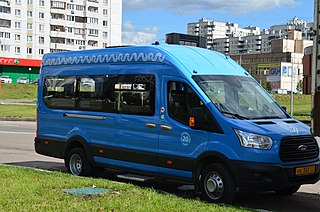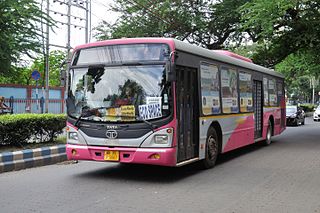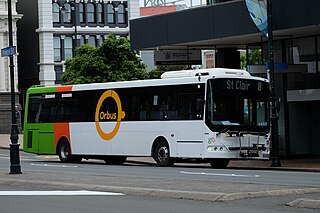
Hong Kong has a highly developed transport network, encompassing both public and private transport. Based on Hong Kong Government's Travel Characteristics Survey, over 90% of daily journeys are on public transport, the highest rate in the world. However, in 2014 the Transport Advisory Committee, which advises the Government on transportation issues, issued a report on the much-worsened congestion problem in Hong Kong and pointed at the excessive growth of private cars during the past 10–15 years.

Invercargill is the southernmost and westernmost city in New Zealand, and one of the southernmost cities in the world. It is the commercial centre of the Southland region. The city lies in the heart of the wide expanse of the Southland Plains to the east of the Ōreti or New River some 18 km north of Bluff, which is the southernmost town in the South Island. It sits amid rich farmland that is bordered by large areas of conservation land and marine reserves, including Fiordland National Park covering the south-west corner of the South Island and the Catlins coastal region.

Rail transport in New Zealand is an integral part of New Zealand's transport network, with a nationwide network of 4,375.5 km (2,718.8 mi) of track linking most major cities in the North and South Islands, connected by inter-island rail and road ferries. Rail transport in New Zealand has a particular focus on bulk freight exports and imports, with 19 million net tonnes moved by rail annually, and 99.5% of New Zealand's exports and imports being transported through the country's seaports.

Marshrutnoye taksi, commonly known by the acronym Marshrutka, are share taxis found in Eastern Europe and the republics of the former Soviet Union. Usually vans, they drive along set routes, depart only when all seats are filled, and may have higher fares than buses. Passengers can board a marshrutka anywhere along its route if there are seats available.
Mount Cook Airline was a regional airline based in Christchurch, New Zealand. Formerly part of the Mount Cook Group and latterly a subsidiary of Air New Zealand, it operated scheduled services throughout the country under the Air New Zealand Link brand. In December 2019, the brand name was retired with all services operated under the Air New Zealand banner.

The Main South Line, sometimes referred to as part of the South Island Main Trunk Railway, is a railway line that runs north and south from Lyttelton in New Zealand through Christchurch and along the east coast of the South Island to Invercargill via Dunedin. It is one of the most important railway lines in New Zealand and was one of the first to be built, with construction commencing in the 1860s. At Christchurch, it connects with the Main North Line to Picton, the other part of the South Island Main Trunk.
The Southerner was a passenger express train in New Zealand's South Island between Christchurch and Invercargill along the South Island Main Trunk, that ran from 1970 to 2002. It was one of the premier passenger trains in New Zealand and its existence made Invercargill the southernmost passenger station in the world.

Invercargill Airport is a fully secured controlled international designated airport located 1.6 km west of the Central business district of Invercargill at the bottom of the South Island of New Zealand. It is the southernmost controlled airport in the Commonwealth. Formed on land reclaimed from the Waihopai/New River Estuary in 1938, the airport was prone to flooding, notably in 1984 when it was inoperable for two months. The Invercargill City Council considered moving the airport back to Dawson Farm, Myross Bush, the original site up to 1942. Instead, a large flood protection scheme was built, but during its construction heavy rain and an unusually high tidal surge flooded it again in 1987. There have been no problems since. The airport has a main secured terminal, a backup international secured terminal and 5 tarmac gates. Invercargill is the eleventh-busiest airport in New Zealand by passenger traffic.

The transport system of Kolkata, a city in India, is a mix of modern mass rapid transport and old transport modalities like rickshaws. Kolkata is connected to the rest of India by the National Highways, the extensive network of the Indian Railways, National Waterways and by air. The most traffic to Northeast India route is via Kolkata.

The public transport system of Otago centres around the cities of Dunedin and Queenstown, under the brand name Orbus. Public transport in the region is provided using buses and ferries. Despite sharing a name, the systems in Dunedin and Queenstown are isolated from one another.

Ritchies Transport is a New Zealand private bus operator, owned by KKR. It was established in 1972 and describes itself as "the largest privately owned bus and coach transport operator in New Zealand" with a fleet of over 1500 vehicles spread across depots nationwide. It owns a 46% stake in InterCity.

Public transport in Christchurch, New Zealand, consists of bus services operated by two bus companies supported by a ferry, all jointly marketed as Metro, a division of Environment Canterbury (ECan).

Invercargill Passenger Transport Ltd was a bus company which operated public transport routes in Dunedin and Invercargill as well as school transport services in those cities as well as Queenstown and leisure and tourism transport services throughout the South Island of New Zealand

Urban bus transport is the main form of public transport in New Zealand. Two of the country's largest cities, Auckland and Wellington, also have suburban rail systems, while some cities also operate local ferry services. There are no rapid transit metros and no remaining tram systems active anywhere in New Zealand, though trams once had a major role in New Zealand's public transport.

Trams in New Zealand were a major form of transport from the 19th century into the mid-20th century. New Zealand's first (horse) tramway was established in 1862 (Nelson), followed by a steam tramway in 1871 (Thames), and the first electric tramway in 1900. In New Zealand railway terminology a bush tramway is an industrial tramway, which usually did not carry passengers.
Transport in Shanghai is provided by an extensive network of modes including metro, cycling, bus and taxis, as well as an expansive network of roadways, and airports. Shanghai has invested heavily in public transportation before and after the 2010 World Expo, including the construction of the Hongqiao transportation hub of high-speed rail, air, metro and bus routes.
Colin David Campbell is a New Zealand Roman Catholic bishop. He was the sixth bishop of the Roman Catholic Diocese of Dunedin from 2004 until 2018, when he reached the retirement age of 75. He is currently the interim Rector of Holy Cross Seminary in Auckland.
The Tramway Historical Society Inc. is located at the Ferrymead Heritage Park in the Christchurch, New Zealand suburb of Ferrymead and operates the standard gauge Ferrymead Tramway. Trams have operated at Ferrymead since 1968, with progressive extensions built between 1970 and 1984 allowing trams to operate within the boundaries of the Heritage Park. The Society also operates and own a collection of historic trolley buses and diesel buses.
Mainland Air is a general aviation, flight training and air charter company operating out of Dunedin International Airport in New Zealand.















